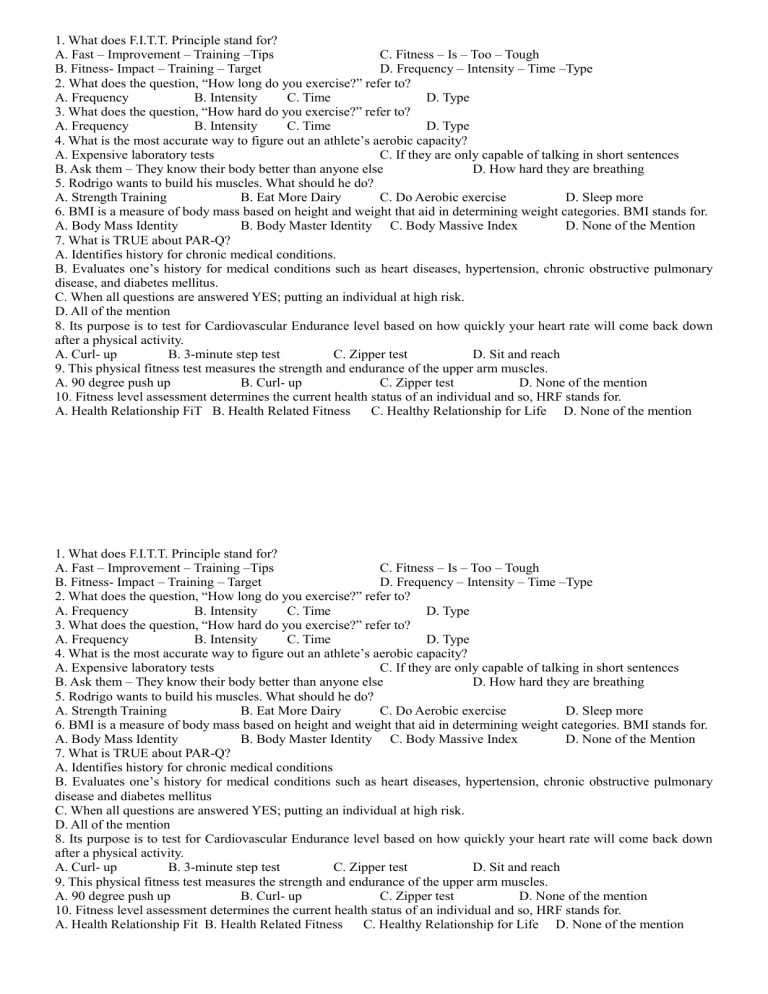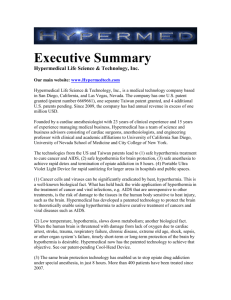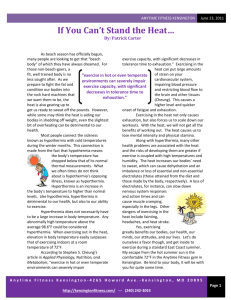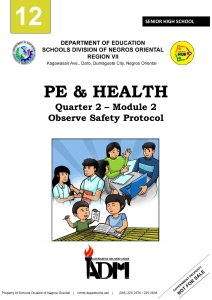
1. What does F.I.T.T. Principle stand for? A. Fast – Improvement – Training –Tips C. Fitness – Is – Too – Tough B. Fitness- Impact – Training – Target D. Frequency – Intensity – Time –Type 2. What does the question, “How long do you exercise?” refer to? A. Frequency B. Intensity C. Time D. Type 3. What does the question, “How hard do you exercise?” refer to? A. Frequency B. Intensity C. Time D. Type 4. What is the most accurate way to figure out an athlete’s aerobic capacity? A. Expensive laboratory tests C. If they are only capable of talking in short sentences B. Ask them – They know their body better than anyone else D. How hard they are breathing 5. Rodrigo wants to build his muscles. What should he do? A. Strength Training B. Eat More Dairy C. Do Aerobic exercise D. Sleep more 6. BMI is a measure of body mass based on height and weight that aid in determining weight categories. BMI stands for. A. Body Mass Identity B. Body Master Identity C. Body Massive Index D. None of the Mention 7. What is TRUE about PAR-Q? A. Identifies history for chronic medical conditions. B. Evaluates one’s history for medical conditions such as heart diseases, hypertension, chronic obstructive pulmonary disease, and diabetes mellitus. C. When all questions are answered YES; putting an individual at high risk. D. All of the mention 8. Its purpose is to test for Cardiovascular Endurance level based on how quickly your heart rate will come back down after a physical activity. A. Curl- up B. 3-minute step test C. Zipper test D. Sit and reach 9. This physical fitness test measures the strength and endurance of the upper arm muscles. A. 90 degree push up B. Curl- up C. Zipper test D. None of the mention 10. Fitness level assessment determines the current health status of an individual and so, HRF stands for. A. Health Relationship FiT B. Health Related Fitness C. Healthy Relationship for Life D. None of the mention 1. What does F.I.T.T. Principle stand for? A. Fast – Improvement – Training –Tips C. Fitness – Is – Too – Tough B. Fitness- Impact – Training – Target D. Frequency – Intensity – Time –Type 2. What does the question, “How long do you exercise?” refer to? A. Frequency B. Intensity C. Time D. Type 3. What does the question, “How hard do you exercise?” refer to? A. Frequency B. Intensity C. Time D. Type 4. What is the most accurate way to figure out an athlete’s aerobic capacity? A. Expensive laboratory tests C. If they are only capable of talking in short sentences B. Ask them – They know their body better than anyone else D. How hard they are breathing 5. Rodrigo wants to build his muscles. What should he do? A. Strength Training B. Eat More Dairy C. Do Aerobic exercise D. Sleep more 6. BMI is a measure of body mass based on height and weight that aid in determining weight categories. BMI stands for. A. Body Mass Identity B. Body Master Identity C. Body Massive Index D. None of the Mention 7. What is TRUE about PAR-Q? A. Identifies history for chronic medical conditions B. Evaluates one’s history for medical conditions such as heart diseases, hypertension, chronic obstructive pulmonary disease and diabetes mellitus C. When all questions are answered YES; putting an individual at high risk. D. All of the mention 8. Its purpose is to test for Cardiovascular Endurance level based on how quickly your heart rate will come back down after a physical activity. A. Curl- up B. 3-minute step test C. Zipper test D. Sit and reach 9. This physical fitness test measures the strength and endurance of the upper arm muscles. A. 90 degree push up B. Curl- up C. Zipper test D. None of the mention 10. Fitness level assessment determines the current health status of an individual and so, HRF stands for. A. Health Relationship Fit B. Health Related Fitness C. Healthy Relationship for Life D. None of the mention 11 This refers to the excessive loss of water from the body, usually through perspiration or sweating, urination, or evaporation. A. Dehydration B. Overexertion C. Hypothermia D. Hyperthermia 12. This refers to the detrimental cause of excessive training. A. Dehydration B. Overexertion C. Hypothermia D. Hyperthermia 13. This is an alarming rise in body temperature, which is an effect of exercising in a very humid environment. It sets the stage for heat stress and even heat stroke, the potentially fatal collapse of the temperature-regulating mechanism. A. Dehydration B. Overexertion C. Hypothermia D. Hyperthermia 14Excessively low body temperature, characterized by uncontrollable shivering, loss of coordination, and mental confusion. A. Dehydration B. Overexertion C. Hypothermia D. Hyperthermia 15. Which of the following is NOT one of the symptoms of Hyperthermia? A. Heat Cramps B. Heat exhaustion C. Heatstroke D. Shivering 16. When is the advisable time to replenish lost fluids? A. After Exercise B. If feeling thirsty C. Before feeling thirsty D. None of the Above 17. Why does overexertion or overtraining usually happens to athletes or exercisers? A. Pursuit of high-level performance B. For fame C. To lose weight rapidly D. To achieve the ideal body structure 18. What is the best thing that we should remember to avoid hyperthermia? A. Minimal Hydration B. Use dark colored clothing C. Exercise in extremely heat and humidity D. Rest Periodically 19. Which of the following points do we need to consider in preparation for any outdoor physical activity? A. Use sunscreen. B. Eat and hydrate well C. know the environment well. D. All of the Above 20.What does MVPA stand for? A. Minimal and Vigorous Physical Activity C. Moderate to Vigorous Physical Activity B. Maximum to Vigorous Physical Activity D. Medial and Vivid Physical Activity 11 This refers to the excessive loss of water from the body, usually through perspiration or sweating, urination, or evaporation. A. Dehydration B. Overexertion C. Hypothermia D. Hyperthermia 12. This refers to the detrimental cause of excessive training. A. Dehydration B. Overexertion C. Hypothermia D. Hyperthermia 13. This is an alarming rise in body temperature, which is an effect of exercising in a very humid environment. It sets the stage for heat stress and even heat stroke, the potentially fatal collapse of the temperature-regulating mechanism. A. Dehydration B. Overexertion C. Hypothermia D. Hyperthermia 14Excessively low body temperature, characterized by uncontrollable shivering, loss of coordination, and mental confusion. A. Dehydration B. Overexertion C. Hypothermia D. Hyperthermia 15. Which of the following is NOT one of the symptoms of Hyperthermia? A. Heat Cramps B. Heat exhaustion C. Heatstroke D. Shivering 16. When is the advisable time to replenish lost fluids? A. After Exercise B. If feeling thirsty C. Before feeling thirsty D. None of the Above 17. Why does overexertion or overtraining usually happens to athletes or exercisers? A. Pursuit of high-level performance B. For fame C. To lose weight rapidly D. To achieve the ideal body structure 18. What is the best thing that we should remember to avoid hyperthermia? A. Minimal Hydration B. Use dark colored clothing C. Exercise in extremely heat and humidity D. Rest Periodically 19. Which of the following points do we need to consider in preparation for any outdoor physical activity? A. Use sunscreen. B. Eat and hydrate well C. know the environment well. D. All of the Above 20.What does MVPA stand for? A. Minimal and Vigorous Physical Activity C. Moderate to Vigorous Physical Activity B. Maximum to Vigorous Physical Activity D. Medial and Vivid Physical Activity Key to correction 1. d 2. c 3. b 4. d 5a 6. d 7.d 8.b 9.a 10.b 11. a 12. b 13. d 14. c 15. d 16. c 17. a 18. d 19. d 20. c




